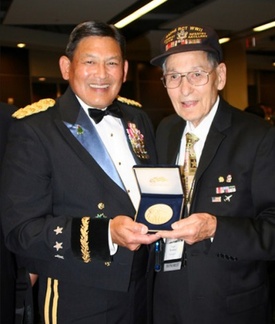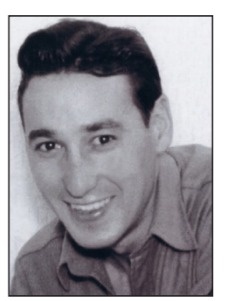If you’ve ever found yourself looking for someone you’ve never met in a crowded setting, hoping to connect with another pair of eyes that are seemingly on the same quest, I suggest you turn around.
Scouring a hotel lobby in Chicago with fellow Hanashi Oral History Program volunteers Richard Hawkins and Darrell Kunitomi, we were on the lookout for a Hapa (a Hawaiian term indicating someone of mixed Asian heritage, in this case half Japanese) World War II veteran. Turning 180 degrees to realize that we were standing back-to-back is how I first met Virgil William Westdale.
He was 6′-0″ tall, had a slender build, and his Japanese heritage wasn’t apparent. We knew we were off to a good start, as everyone enjoyed a good laugh at the situation rather than showing any anger or frustration.
Virgil William Nishimura was born in the farm country of Millersburg, Indiana, yet had a strong sense of adventure that lured him to the sky. He was interested in learning to fly, soaring in the endless blue with its occasional puffs of white clouds, and set off to meet his goal. He earned and was issued a private pilot license.
One day an FAA (Federal Aviation Administration) official asked to see him, and with an apology but without further explanation, asked him for his license. Though likely an eternity to him, Westdale’s license was returned some months later, and he was allowed to fly again.
Given his career plan and the state of war, Westdale discussed with his family, and decided to change his name from Nishimura (nishi, meaning west, and mura, meaning village) to Westdale. He joined the Army Air Corps in October 1942. He served in the Enlisted Reserve Corps as a civilian while continuing advanced training in acrobatics, instrument, cross-country flying, and commercial.
Having passed his exams, he was eager to receive his commercial pilot license. Being such a strong pilot and impressing his instructors, they asked him to stay on to train cadets at the War Training Center as an instrument flight Instructor. He was an instructor for about four months — then life changed.
His Japanese heritage must have drawn someone’s attention because Westdale got transferred to the 442nd Regimental Combat Team (RCT), a segregated Japanese American infantry unit. He reported to 1st Sgt. Jack Wakamatsu at Camp Shelby, Mississippi in September 1943. Wakamatsu took one look at Westdale and another Hapa soldier, Clifford Hana, then asked, “What can I do for you gentlemen?” Noting that they looked non-Japanese to him, the sergeant added that he’d never understand the U.S. government.
As a redhead, Hana was another oddity in the Japanese American unit, so the two men became fast friends. For someone used to working in the sky, life as an infantryman in F Company was an abrupt change as Westdale trained to use a range of weapons, from a rifle, bazooka, BAR (Browning automatic rifle), and even a flamethrower.
When Westdale’s sister learned of his transfer to the infantry, she wrote a letter to Eleanor Roosevelt. She stated that his transfer to the “walking army” was a waste of government money (having trained him to fly) and his talent. Mrs. Roosevelt wrote a letter to the War Department intending to have him transferred to the Air Command. They responded he was short of the required 1,000 flight hours (having completed 960 to that point), which he speculated was likely their excuse to prevent him from flying.
Westdale said, “If they had just let me stay at the flight school, I would have had my additional 40 hours.”
The adjutant general did send orders resulting in Westdale’s transfer to the 442’s 522nd Field Artillery Battalion, Headquarters Battery. Ordered to take a flight in one of their two Piper Cub observation planes, he was excited about the opportunity, thinking this meant he’d get to pilot for them. As it turned out, this was his only time in the plane.
The 100th Battalion/442nd RCT quickly distinguished themselves on the battlefields of Italy and France (noted as one of the most decorated units in U.S. military history for its size and length of service). The 522nd FAB also stood out among other artillery units, recognized for their speed and accuracy. When the 7th Army prepared to make their push into Germany, the 522nd was requested for reassignment to support their divisions.
The Army’s advance into Germany gave Westdale one bright moment of excitement and one of his darkest memories. At one point, they overran the Lager Lechfeld (airfield) and found a field of Messerschmitts covered with camo netting. He posed for a photo next to one of these historic ME 262 jets. Looking it over, he marveled at the design and technological ingenuity, noting how lucky the Allies were that Germany hadn’t conceived this aircraft earlier in the war.

The 522nd comrades were dispersed throughout the advancing units. Some took part in liberating Jewish victims of Hitler’s Holocaust when they came across one of the outer camps of the vast Dachau complex. Being near the location of the ovens, Westdale mentioned seeing smoke rising from the ground. They also found snow-covered survivors of a death march.
Westdale recalled meeting some of these emaciated survivors as they approached looking for food. U.S. soldiers were warned not to feed them, as their systems would not tolerate solid food, having been starved for so long. Some soldiers feeling sorry for them did provide some rations only to discover their dead bodies shortly afterward.
By the war’s end in Europe, Westdale had accumulated the 60 service points required to go home. Due to an unexplained army SNAFU (Situation Normal: All F***ed Up), he was held back as his Headquarter Battery crew members shipped home. Virgil later boarded an aircraft carrier for the voyage home, which departed from England. Their captain assured everyone they’d be home for New Year’s Day, 1946, but Odin had something else in store for them. The storm they ran into slammed the ship with 80-mph winds. The front of the flight deck and bulkheads were damaged.
Westdale recalled, “Now starting out everything was fine … we ate ice cream, got right back in line right away.” Then the storm struck! He said, “Guys were sitting in the latrine with life jackets on.” He and a friend were trying not to get sick by staying in the middle of the ship and distracting themselves by playing double-solitaire. Having to change course by heading south to calmer water, nine days passed before they arrived to see the Statue of Liberty on Jan. 5.
In New Jersey, the men received various medals and sewn-on patches, documenting their service experience for a welcoming public. Westdale hitchhiked to Atterbury, Indiana, where he reported to the “mustering out” (discharge) officer, a major.
Westdale said, “He had my records in front of him, and he called me ‘Sir’ … and he saluted me too.” He added, “It’s the first time a major spoke to a T/5 (technician/corporal) in my viewpoint.” He also noted, “I think they knew what the 442nd was and what they had done, and so on, so he was happy to honor me in that respect.”
Westdale arrived at his sister’s home, where his entire family had been waiting for him. Thinking back, he stated, “We have a family photo of that.”

His friend Clifford Hana was not as fortunate, having died in Europe.
With his GI Bill education benefits, Westdale attended Western Michigan College (now University), earning two degrees. First working for Burroughs Corp. and ending his career at AM International, he advanced from a paper analyst to a principal scientist. By the time Westdale retired in 1987, he had 25 patents awarded (or pending) in his name, advancing the field of image duplication on paper, among others.
Not one to sit idle, Westdale took a turn at real estate development and then worked in security with the TSA, retiring at age 91 as its oldest employee. He even took up tap and ballroom dancing at age 75 and hung up those shoes at age 91. Still not letting any moss gather, he co-authored his story in the book “Blue Skies and Thunder: Farm Boy, Pilot, Inventor, TSA Officer, and WWII Soldier of the 442nd Regimental Combat Team,” published in December 2009. He promoted his book, educating younger generations about his experiences as a Japanese American during WWII.

Another highlight of this very active “retirement” occurred in Washington, D.C., where Westdale gathered with many of his fellow Nisei WWII veterans in 2011. They assembled to receive the Congressional Gold Medal from a bipartisan gathering of members of both houses of Congress. The Congressional Gold Medal is the highest award presented to a civilian to express the nation’s appreciation for distinguished achievements and contributions.
Another nod to the achievement of these noble yet very humble warriors occurred on June 3, 2021. The U.S. Postal Service issued the “Go For Broke: Japanese American Soldiers of WWII” Forever stamp. Along with other veterans representing regions from across the nation, Westdale recorded a short address for the Stamp Our Story Committee unveiling program in Los Angeles, the first city of issue.
It was an honor to have heard Westdale’s story. He did me the favor of allowing me to stay in contact with him over the years. Invited as a guest speaker to a 442nd F Company reunion, I had a chance meeting (though I wonder if anything is chance) with Mr. Hodges. He was looking for the friend of his Hapa uncle. His description didn’t ring a bell for the men he spoke to. I heard something familiar in this story and offered to call Westdale
Though not the man Mr. Hodges was looking for, he discovered another friend of his uncle and the two men spent the following years happily sharing memories, one of a lost friend and the other of his lost Uncle Clifford. Hopefully, in this way, I returned Westdale’s generous favor.
Having more than lived a full life at 104, Westdale left his family and friends on Feb. 2, 2022. He left them with wonderful memories of shared moments in time. I’m certain they take some comfort in knowing he earned his wings many decades earlier, and he’s once again taking flight.
Postscript: On Sept. 11, 2006, Westdale received his commercial pilot license, in the mail! After giving this new opportunity some thought at age 88, and working at the TSA at the time, he decided not to apply for work as a pilot.
*This article was originally published in The Rafu Shimpo on November 11, 2022.
© 2022 Robert M. Horsting



